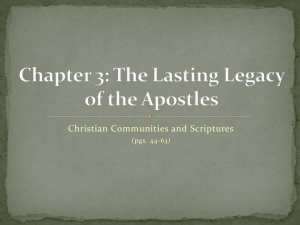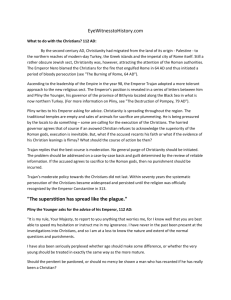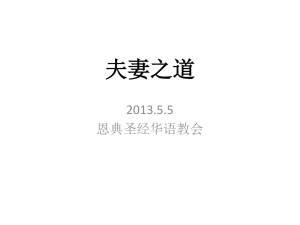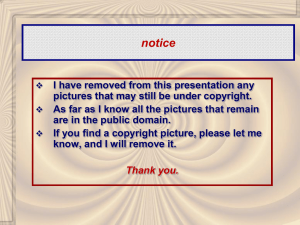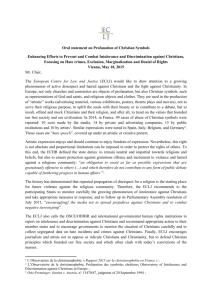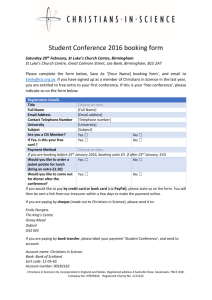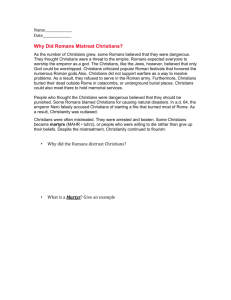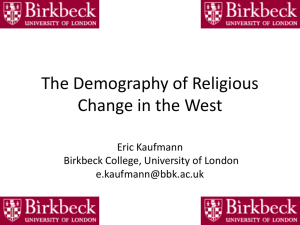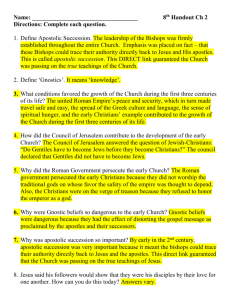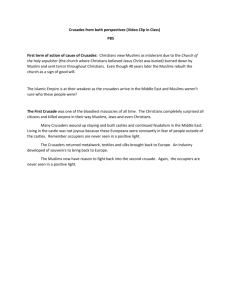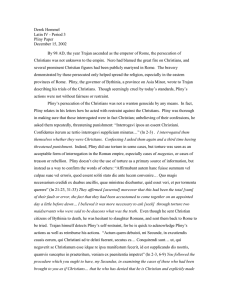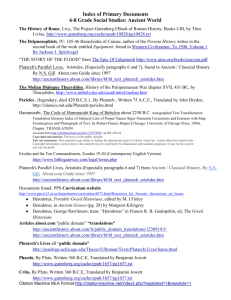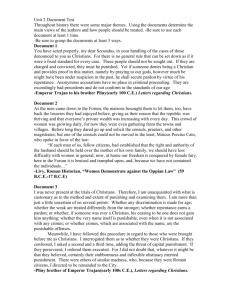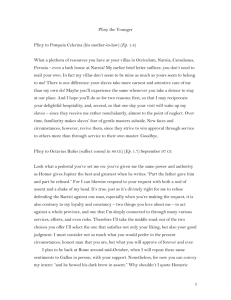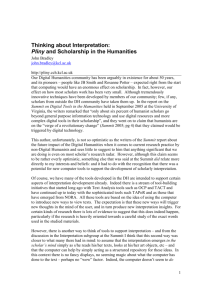Primary Source Reading Assignments - Online
advertisement
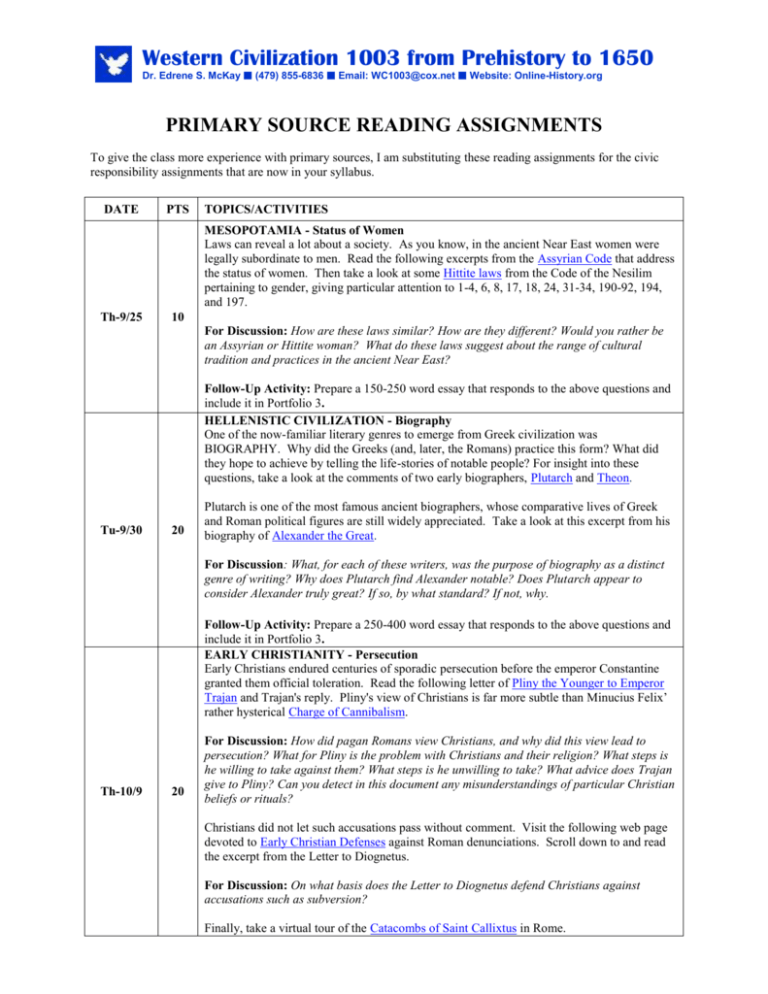
Western Civilization 1003 from Prehistory to 1650 Dr. Edrene S. McKay (479) 855-6836 Email: WC1003@cox.net Website: Online-History.org PRIMARY SOURCE READING ASSIGNMENTS To give the class more experience with primary sources, I am substituting these reading assignments for the civic responsibility assignments that are now in your syllabus. DATE PTS TOPICS/ACTIVITIES MESOPOTAMIA - Status of Women Laws can reveal a lot about a society. As you know, in the ancient Near East women were legally subordinate to men. Read the following excerpts from the Assyrian Code that address the status of women. Then take a look at some Hittite laws from the Code of the Nesilim pertaining to gender, giving particular attention to 1-4, 6, 8, 17, 18, 24, 31-34, 190-92, 194, and 197. Th-9/25 10 For Discussion: How are these laws similar? How are they different? Would you rather be an Assyrian or Hittite woman? What do these laws suggest about the range of cultural tradition and practices in the ancient Near East? Follow-Up Activity: Prepare a 150-250 word essay that responds to the above questions and include it in Portfolio 3. HELLENISTIC CIVILIZATION - Biography One of the now-familiar literary genres to emerge from Greek civilization was BIOGRAPHY. Why did the Greeks (and, later, the Romans) practice this form? What did they hope to achieve by telling the life-stories of notable people? For insight into these questions, take a look at the comments of two early biographers, Plutarch and Theon. Tu-9/30 20 Plutarch is one of the most famous ancient biographers, whose comparative lives of Greek and Roman political figures are still widely appreciated. Take a look at this excerpt from his biography of Alexander the Great. For Discussion: What, for each of these writers, was the purpose of biography as a distinct genre of writing? Why does Plutarch find Alexander notable? Does Plutarch appear to consider Alexander truly great? If so, by what standard? If not, why. Follow-Up Activity: Prepare a 250-400 word essay that responds to the above questions and include it in Portfolio 3. EARLY CHRISTIANITY - Persecution Early Christians endured centuries of sporadic persecution before the emperor Constantine granted them official toleration. Read the following letter of Pliny the Younger to Emperor Trajan and Trajan's reply. Pliny's view of Christians is far more subtle than Minucius Felix’ rather hysterical Charge of Cannibalism. Th-10/9 20 For Discussion: How did pagan Romans view Christians, and why did this view lead to persecution? What for Pliny is the problem with Christians and their religion? What steps is he willing to take against them? What steps is he unwilling to take? What advice does Trajan give to Pliny? Can you detect in this document any misunderstandings of particular Christian beliefs or rituals? Christians did not let such accusations pass without comment. Visit the following web page devoted to Early Christian Defenses against Roman denunciations. Scroll down to and read the excerpt from the Letter to Diognetus. For Discussion: On what basis does the Letter to Diognetus defend Christians against accusations such as subversion? Finally, take a virtual tour of the Catacombs of Saint Callixtus in Rome. Primary Source Reading Assignments DATE PTS Page 2 TOPICS/ACTIVITIES For Discussion: Why did early Christians descend into the CATACOMBS? What evidence did they leave behind of their presence, and what does that evidence suggest about what the Christians did there? What forms did early Christian art take in the catacombs, and how did it change when they could live and worship in the light of day? Follow-Up Activity: Prepare a 250-400 word essay that responds to the above questions and include it in Portfolio 4. Th-10/16 20 EARLY CHRISTIANITY - Heresy Even before the church was fully established, Christian thinkers debated the authenticity and value of a variety of texts pertaining to Jesus and his teachings. Ultimately the writings gathered as the New Testament became the Official Version of Christian Teaching, and all alternative versions were suppressed. One alternative was a collection of writings now known as the Gnostic Gospels. Read the following Introduction to the Gnostic Gospels. When you finish, take a look at some examples of Gnostic texts: the sayings of Jesus in the Gospel According to Thomas, the poem Thunder Perfect Mind, and The Gospel of Pistis Sophia, Book 1. For Discussion: How do these texts differ from the official four Gospels of the New Testament? How would you characterize the language of these texts? How do they present Jesus and his teachings? How do they present the experience of understanding or knowing God? Why do you think the proponents of the official Gospels would have wanted to suppress such texts? Follow-Up Activity: Prepare a 250-400 word essay that responds to the above questions and include it in Portfolio 5. 10/23 20 THE CALAMITOUS 14TH CENTURY - The Black Death The following sources relate to the Black Death, which reached the shores of Italy in the spring of 1348. The first is a primary source (an eyewitness account), the second is secondary (written by someone who was not present), and the third contains primary sources with commentary. Examine each of these sources so that you are able to answer the questions below. The Florentine Chronicle http://jefferson.village.virginia.edu/osheim/marchione.html Satan Triumphant: The Black Death http://www.historyguide.org/ancient/lecture29b.html The Black Death, 1348 http://www.ibiscom.com/plague.htm 10/30 For Discussion: How do you tell the difference between a primary and a secondary source? What type of information (facts, artwork, interpretation, social commentary) does each of these sources provide? Which source do you find most helpful in understanding what actually happened in Florence in 1348? If you find discrepancies in the three accounts, which source do you think is most accurate? Why? Which source do you find most interesting? Most dramatic? Most shocking? If someone only had time to read one of these sources, which would you recommend? Follow-Up Activity: Prepare a 250-400 word essay that responds to the above questions and include it in Portfolio 5.
